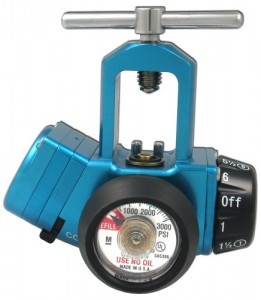Highlight your local manufacturers: a Friday Freebie

An Oxy-Serve II Medical Oxygen Conserving Regulator, one of the guzintas we featured in Made Here. (Photo by SP Medical LLC.)
On occasional Fridays I’ll offer specific ideas for print/online content.
My first Friday Freebie is a feature The Plain Dealer ran on its Sunday Business front for several years. We called it “Made Here.”
Each item was just a few inches long: The name of a product, the name of the manufacturer and its location, explanations of how it was made and how it was used, and a bit of background or product trivia. We ran a photo of the product with each one — handout shots, usually.
We insisted that the product had to be made, or at least assembled, in our area. And it had to be a product. Those two rules would seem simple, but of course they weren’t. Companies that were based in our area but did their manufacturing elsewhere tried to sneak in. And others in service industries wanted to be recognized, too, but the “Made Here” title kept us on track.
The feature was popular with our blue-collar audience as well as with their bosses. What I liked most was that it gave a lot of hard-working men and women a chance to point something out in the paper and say, “I made that.” When you make what a colleague, Steve Talbott, called guzintas — pieces and parts that goes inta other stuff — you don’t get to boast about it very often.
We got a lot of submissions when we first announced and started the feature. The main obstacle then was sorting them into three piles — the rejects that broke the rules, the ones that had complete info, and the ones that needed follow-up. It turned out that most needed at least a little follow-up, usually to flesh out the “how it’s made” and background parts or to beg for a photo. And it required regular reminders that we still wanted more submissions.
We tried handing these out to different reporters, but it was most efficient to settle on one person who could take ownership of the feature. At least that was the theory. We had to shift it around as reporters left. While some of our choices got the idea and ran with it, others just saw it as drudgery, putting off calls until they had completely used up the backlog. One key to a feature like this is to always work several weeks ahead, since small companies without PR staffs will often take a long time to respond.
Nowadays, you could build an online submission form that wouldn’t go through until all the categories were completed and a photo was uploaded, which would make this more efficient. But do expect to have to do some massaging of what comes in.
